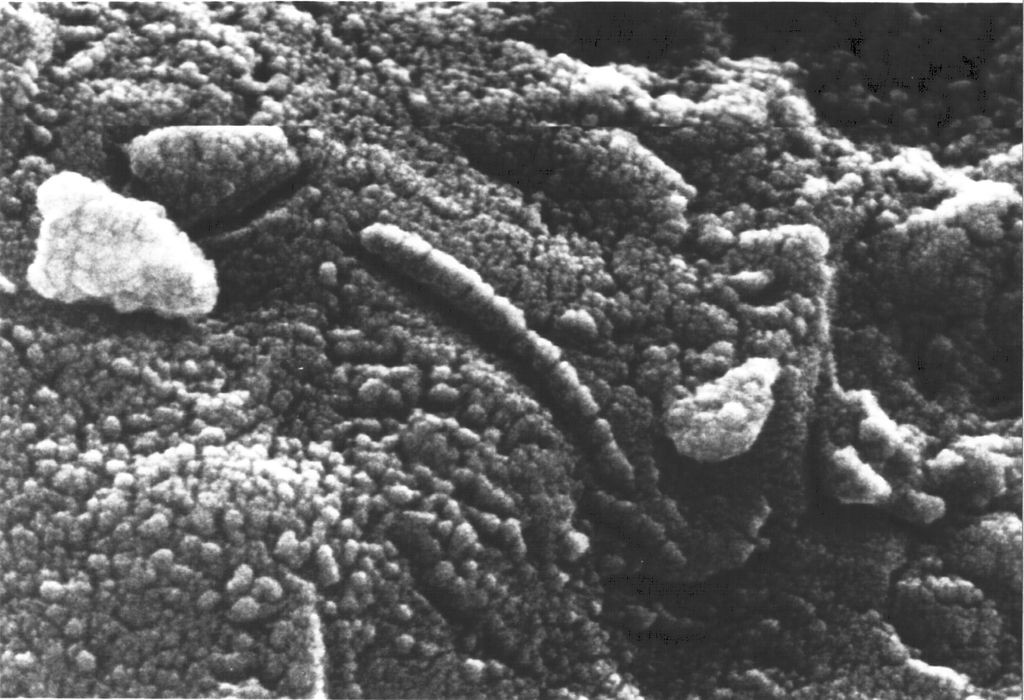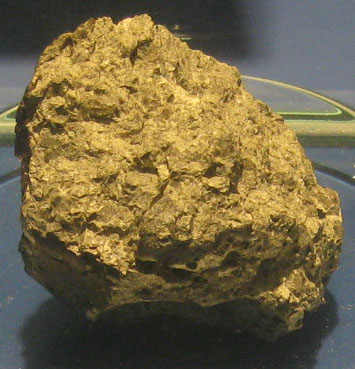Allan Hills 84001 (commonly abbreviated ALH 84001) is a meteorite that was found in Allan Hills, Antarctica on December 27, 1984 by a team of U.S. meteorite hunters. What makes it so special that it is responsible for worldwide headlines on August 6, 1996, when NASA scientists announced that it might contain evidence for microscopic fossils of Martian bacteria based on carbonate globules observed.
A Meteorite from a “Wet” Mars
ALH84001 is a meteorite thought to be from Mars. In general, meteorites are a pieces of debris from a source such as an asteroid or a comet, which originates in outer space and survives its impact with the Earth‘s surface. On discovery, ALH 84001‘s mass was 1.93 kilograms. The piece of rock is considered to be one of the oldest pieces of the Solar System, proposed to have crystallized from molten rock 4.091 billion years ago. Based on chemical analyses, it is thought to have originated on Mars from a period when liquid water existed on the now barren planet‘s surface. The theory holds that ALH84001 was blasted off from the surface of Mars by a meteorite impact about 17 million years ago and fell on Earth roughly 13,000 years ago, whereas these dates were established by a variety of radiometric dating techniques. Other meteorites that have potential biological markings have generated less interest because they do not originate from a “wet” Mars. ALH84001 is the only meteorite collected from such a time period. In October 2011 it was reported that isotopic analysis indicated that the carbonates in ALH84001 were precipitated at a temperature of 18 °C with water and carbon dioxide from the Martian atmosphere. The carbonate carbon and oxygen isotope ratios imply deposition of the carbonates from a gradually evaporating subsurface water body, probably a shallow aquifer meters or tens of meters below the surface.

The electron microscope revealed chain structures in meteorite fragment ALH84001
Evidence for Extraterrestrial Life
Composition analysis by NASA revealed a kind of magnetite that on Earth, is only found in association with certain microorganisms. Published in an article in Science by David S. McKay of NASA on August 6, 1996, it was claimed that the meteorite may contain evidence of traces of life from Mars. Under the scanning electron microscope structures were revealed that some scientists interpreted as fossils of bacteria-like lifeforms. The structures found on ALH 84001 are 20–100 nanometres in diameter, similar in size to theoretical nanobacteria, but smaller than any known cellular life at the time of their discovery. The supposed fossil shapes were so small they could only have been the remains of hypothetical “nanobacteria.” A more plausible explanation, according to other researchers, was that the tiny artifacts are uneven patches in the coating used to prepare the samples for electron microscopy.[3] If the structures are in fact fossilized lifeforms, as proposed by the so-called biogenic hypothesis of their formation, they would be the first solid evidence of the existence of extraterrestrial life, aside from the chance of their origin being terrestrial contamination.
The announcement of possible extraterrestrial life caused considerable controversy and it even prompted the President of the United States Bill Clinton to make a formal televised announcement to mark the event. In August 2002, another NASA team led by Thomas-Keptra published a study indicating that 25% of the magnetite in ALH 84001 occurs as small, uniform-sized crystals that, on Earth, is associated only with biologic activity, and that the remainder of the material appears to be normal inorganic magnetite. The extraction technique did not permit determination as to whether the possibly biological magnetite was organized into chains as would be expected. In November 2009, a team of scientists at Johnson Space Center, including McKay, argued that since their original paper was published, the biogenic hypothesis has been “further strengthened by the presence of abundant fossil-like structures in other Martian meteorites.” However, the scientific consensus is that “morphology alone cannot be used unambiguously as a tool for primitive life detection.” Interpretation of morphology is notoriously subjective, and its use alone has led to numerous errors of interpretation.
ALH 84001 Aftermath
Nevertheless, supporters of the panspermia hypothesis see ALH84001 as one of their major evidence. Panspermia is a hypothesis proposing that microscopic life forms that can survive the effects of space, such as extremophiles, become trapped in debris that is ejected into space after collisions between planets and small Solar System bodies that harbor life. Overall, the hypothesis that ALH84001 contains evidence for extraterrestrial life has not found wide acceptance, although there are strong indications that Mars may once have been hospitable to life.[2] The iconic meteorite became the grist for many imaginations. The TV show The X-files depicted an ALH84001 look-a-like with live bugs in it, and a Dan Brown novel imagined a conspiracy to cover-up extraterrestrial evidence from a space rock.[3]
The Red Planet – Professor Carolin Crawford, [7]
References and Further Reading:
- [1] EVIDENCE FOR ANCIENT MARTIAN LIFE. E. K. Gibson Jr., F. Westall, D. S. McKay, K. Thomas-Keprta, S. Wentworth, and C. S. Romanek, Mail Code SN2, NASA Johnson Space Center, Houston TX 77058, USA.
- [2] ALH84001 at Britannica Online
- [3] The Continuing Controversy of the Mars Meteorite By Michael Schirber – Oct 21, 2010 at astrobiology magazine
- [4] Lost on Mars – The Beagle 2 Mission, SciHi Blog
- [5] Giovanni Sciaparelli and the Martian Cannals, SciHi Blog
- [6] ALH84001 at Wikidata
- [7] The Red Planet – Professor Carolin Crawford, 2013, Gresham College @ youtube
- [8] Mittlefehldt, D. W. (1994). “ALH84001, a cumulate orthopyroxenite member of the SNC meteorite group”. Meteoritics. lpi.usra.edu. pp. 214–221. Retrieved March 18, 2006.
- [9] Stephan, T.; Jessberger, E. K.; Heiss, C. H.; Rost, D. (2003). “TOF-SIMS analysis of polycyclic aromatic hydrocarbons in Allan Hills 84001”. Meteorit. Planet. Sci. uni-muenster.de. pp. 109–116.
- [10] Sawyer, Kathy (2006). The Rock from Mars: A Detective Story on Two Planets. Random House.
- [11] Timeline of Martian meteorites, via Wikidata






